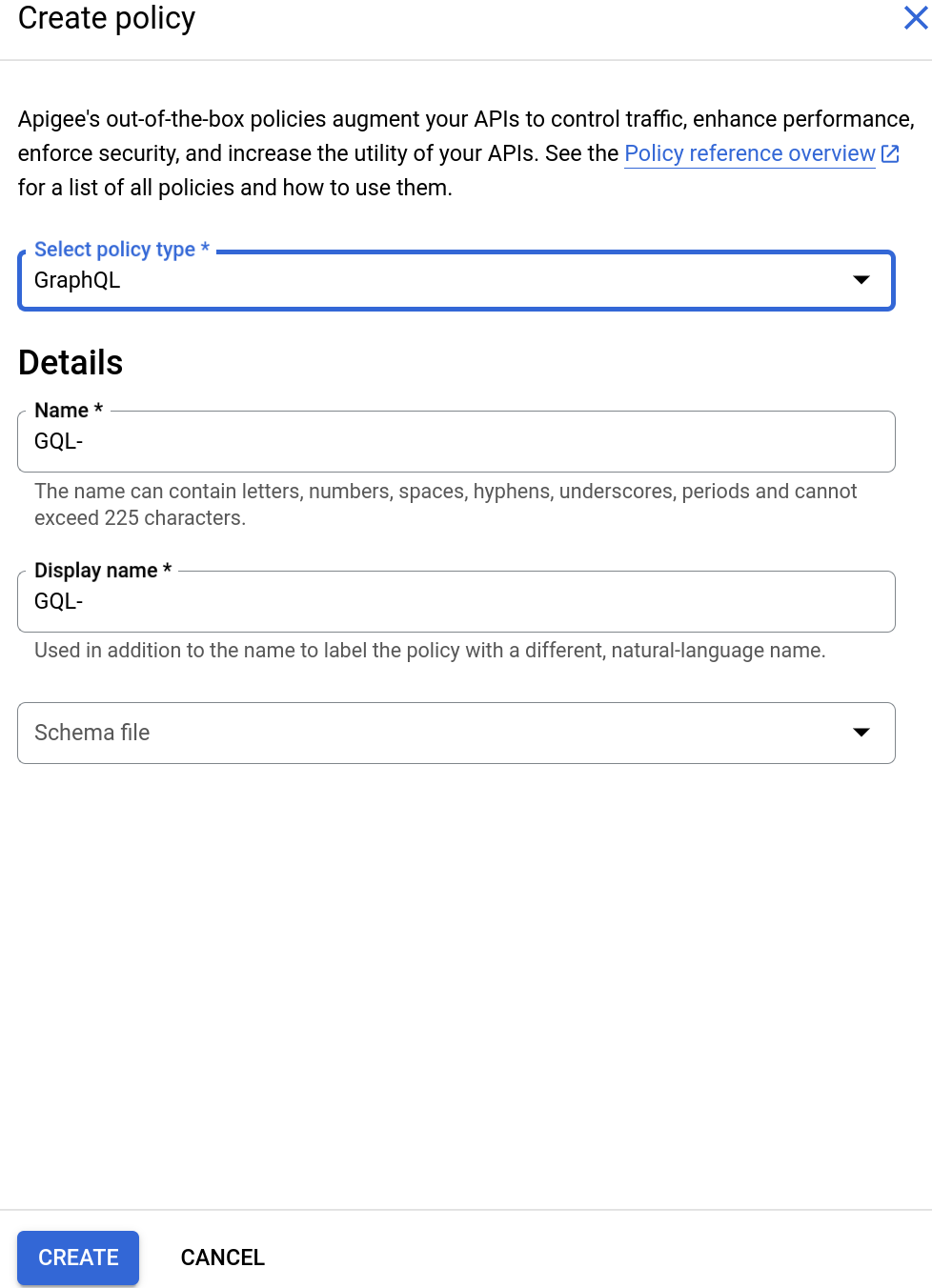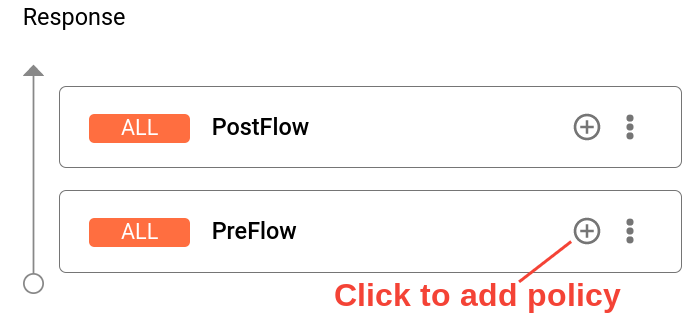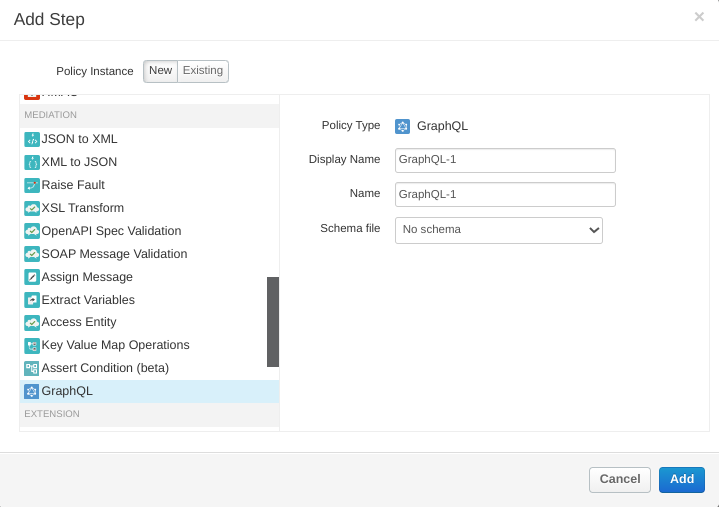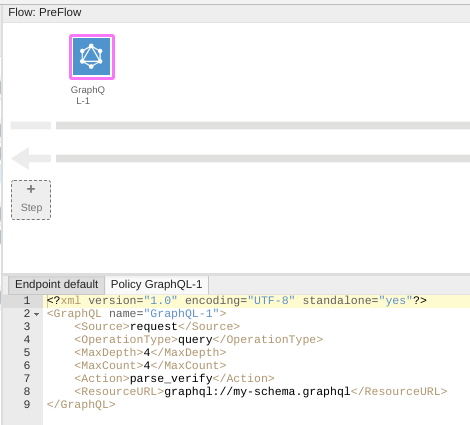Halaman ini berlaku untuk Apigee dan Apigee Hybrid.
Lihat dokumentasi
Apigee Edge.
![]()
Kebijakan GraphQL dapat mengurai payload permintaan GraphQL ke dalam variabel aliran pesan, memverifikasi permintaan terhadap skema GraphQL, atau keduanya.
Kebijakan GraphQL dapat mengurai payload GraphQL menjadi variabel alur pesan, memverifikasi permintaan GraphQL terhadap skema, atau keduanya.
Anda dapat menggunakan kebijakan GraphQL untuk:
- Pastikan API Anda hanya memproses permintaan yang sesuai dengan skema yang Anda berikan.
- Terapkan batasan pada payload dengan menetapkan jumlah maksimum fragmen yang diizinkan.
- Mengaitkan GraphQL dengan produk API.
- Manfaatkan fitur kebijakan Oauth2, VerifyAPIKey, dan Quota, seperti halnya di REST.
GraphQL mendukung jenis payload berikut:
- POST payload graphQL dengan
Content-Type : application/graphql - POST payload graphQL dengan
Content-Type: applcation/json - GET payload graphQL dengan payload adalah parameter kueri
Untuk ringkasan cepat opsi kebijakan GraphQL, lihat Opsi GraphQL di bawah.
Untuk mempelajari GraphQL lebih lanjut, lihat GraphQL.org.
Contoh
Contoh berikut menunjukkan cara mengupload skema GraphQL ke Apigee, dan menggunakannya untuk memvalidasi permintaan dengan konten GraphQL.
Membuat file skema
Untuk menjalankan contoh, buat terlebih dahulu file skema GraphQL dengan konten berikut:
type Query {
allPersons(last: Int): [Person!]!
}
type Mutation {
createPerson(name: String!, age: Int!): Person!
}
type Subscription {
newPerson: Person!
}
type Person {
name: String!
sex: String!
age: Int!
posts: [Post!]!
}
type Post {
title: String!
author: Person!
}Simpan file dengan nama apa pun yang ingin Anda gunakan, diikuti dengan ekstensi .graphql.
Menambahkan kebijakan GraphQL di UI Apigee
Editor Proxy Baru
Pertama, buat kebijakan GraphQL sebagai berikut:
- Login ke UI Apigee.
- Di panel navigasi, pilih Develop > API Proxies.
- Dalam daftar proxy, pilih proxy API yang ingin Anda gunakan kebijakan GraphQL-nya.
- Klik tab KEMBANGKAN.
- Di panel sebelah kiri, klik tombol + di samping folder Policies.
Pada dialog Create policy, klik di kolom Select policy type, lalu scroll ke bawah ke Mediation dan pilih GraphQL.

Masukkan Nama tampilan dan Nama.
Selanjutnya, pilih file skema GraphQL sebagai berikut:
- Klik kolom Schema File. Tindakan ini akan menampilkan pilihan berikut:
- Tidak Ada Skema. Jika Anda memilih opsi ini, Apigee tidak akan menggunakan skema untuk memvalidasi permintaan.
- Mengimpor skema GraphQL (.graphql)
Pilih Impor skema GraphQL (.graphql). Tindakan ini akan menampilkan berikut:

Klik Pilih File, lalu pilih file skema yang Anda buat sebelumnya (yang harus memiliki ekstensi
.graphql). File akan muncul di kolom Nama skema.
- Klik kolom Schema File. Tindakan ini akan menampilkan pilihan berikut:
- Klik Buat untuk membuat kebijakan.
Setelah membuat kebijakan GraphQL, Anda dapat melampirkannya ke langkah di PreFlow:
- Pilih Proxy Endpoints > default > PreFlow di
panel kiri:

- Klik tombol + di samping PreFlow di panel Response
di kanan bawah Editor Visual:

- Dalam dialog Add policy step, pilih kebijakan GQL-.
- Klik Tambahkan untuk melampirkan kebijakan.
- Klik Simpan untuk menyimpan revisi saat ini dengan perubahan Anda.
- Untuk men-deploy perubahan, klik tab Ringkasan, lalu pilih Deploy.
Lihat Opsi GraphQL di bawah untuk mengetahui opsi yang dapat Anda tetapkan untuk kebijakan GraphQL.
Editor Proxy Klasik
- Login ke UI Apigee.
- Di panel navigasi, pilih Develop > API Proxies.
- Dalam daftar proxy, pilih proxy API yang ingin Anda gunakan kebijakan GraphQL-nya.
- Klik tab KEMBANGKAN.
Di panel Flow: PreFlow, klik tombol + Step.

Di panel Tambahkan Langkah, scroll ke bawah di bagian Mediasi, lalu pilih GraphQL.

Panel Tambahkan Langkah menampilkan opsi berikut:
- Nama Tampilan: Nama tampilan kebijakan.
- Nama: Nama internal kebijakan.
- File skema: Opsi untuk mengupload file yang berisi skema GraphQL yang akan digunakan Apigee untuk memvalidasi permintaan dengan konten GraphQL.
Untuk menggunakan skema, lakukan hal berikut:
- Klik kolom Schema File. Tindakan ini akan menampilkan pilihan berikut:
- Tidak Ada Skema. Jika Anda memilih opsi ini, Apigee tidak akan menggunakan skema untuk memvalidasi permintaan.
- Mengimpor skema GraphQL (.graphql)
Pilih Impor skema GraphQL (.graphql). Tindakan ini akan menampilkan berikut:

Klik Pilih File, lalu pilih file skema yang Anda buat sebelumnya (yang harus memiliki ekstensi
.graphql). File akan muncul di kolom Nama skema.
Klik Tambahkan. Panel Flow: PreFlow kini muncul seperti yang ditunjukkan di bawah:

Lihat Opsi GraphQL di bawah untuk mengetahui opsi yang dapat Anda tetapkan untuk kebijakan GraphQL. Untuk contoh ini, biarkan apa adanya.
Untuk men-deploy proxy, klik tab Ringkasan, lalu pilih Deploy.

Sekarang Anda dapat menguji kebijakan GraphQL dengan perintah curl berikut:
curl --location --request POST 'https://PROXY_BASEPATH/HOST_NAME' --data-raw 'query query_name {allPersons {name}}' -kDengan PROXY_BASEPATH adalah basepath proxy dan HOST_NAME adalah nama proxy Anda, termasuk nomor revisi terbaru. Saat Anda menjalankan perintah, Apigee akan memvalidasi permintaan terhadap skema dan menampilkan output berikut.
{
"query query_name {allPersons {name}}": "",
"id": 101
}Berikut contoh permintaan lainnya:
curl --location --request POST 'https://PROXY_BASEPATH/HOST_NAME' --data-raw 'query ilovegql {DEADBEEF}' -kKali ini validasi permintaan gagal dengan pesan error berikut.
{"fault":{"faultstring":"steps.graphQL.SchemaValidationFailed","detail":{"errorcode":"steps.graphQL.SchemaValidationFailed"}}}Opsi GraphQL
GraphPolicy memiliki opsi berikut:
OperationType: Jenis operasi. Opsinya adalah:query: Operasi GraphQL yang setara dengan operasi RESTGET.mutation: Operasi GraphQL yang setara dengan operasi RESTPUT.query_mutation:querydanmutation.
MaxDepth: Kedalaman maksimum kueri, saat ditampilkan sebagai pohon.MaxDepthmemungkinkan Anda memblokir kueri mendalam dalam payload, sehingga Apigee tidak perlu membuat variabel alur yang sangat besar untuk menyimpan nilai. Namun, payload dikirim apa adanya, terlepas dari nilaiMaxDepth.MaxCount: Jumlah maksimum fragmen yang dapat ada dalam payload. Anda dapat menggunakan ini untuk mencegah server backend GraphQL pelanggan menjalankan kueri yang sangat kompleks, sehingga memaksa klien memecah logikanya menjadi payload yang lebih kecil.Action: Salah satu tindakan GraphQL berikut:parseApigee mengurai payload GraphQL ke dalam variabel alur. Anda kemudian dapat menggunakan konten variabel alur dalam kebijakan seperti JavaCallout. Perhatikan bahwaparsejuga memverifikasi payload.verify: Apigee memverifikasi bahwa payload GraphQL sesuai dengan skema yang diupload ke proxy. Anda dapat menggunakanverifyuntuk memastikan bahwa Anda tidak menerima permintaan yang tidak sesuai dengan skema Anda. Hal ini dapat menghemat waktu CPU yang berharga di backend.parse_verify: Mengurai dan memverifikasi payload.
ResourceURL: Jalur ke file skema GraphQL yang digunakan Apigee untuk memverifikasi permintaan GraphQL.`
Untuk mempelajari opsi ini lebih lanjut, lihat halaman Referensi kebijakan GraphQL.

